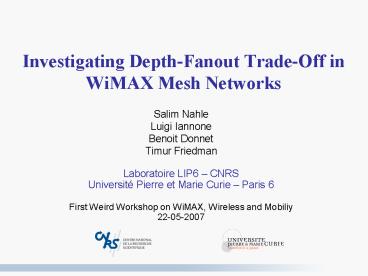Investigating Depth-Fanout Trade-Off in WiMAX Mesh Networks - PowerPoint PPT Presentation
1 / 29
Title:
Investigating Depth-Fanout Trade-Off in WiMAX Mesh Networks
Description:
Salim Nahle Luigi Iannone Benoit Donnet Timur Friedman Laboratoire LIP6 CNRS Universit Pierre et Marie Curie Paris 6 First Weird Workshop on WiMAX, Wireless ... – PowerPoint PPT presentation
Number of Views:114
Avg rating:3.0/5.0
Title: Investigating Depth-Fanout Trade-Off in WiMAX Mesh Networks
1
Investigating Depth-Fanout Trade-Off in WiMAX
Mesh Networks
- Salim Nahle
- Luigi Iannone
- Benoit Donnet
- Timur Friedman
- Laboratoire LIP6 CNRS
- Université Pierre et Marie Curie Paris 6
- First Weird Workshop on WiMAX, Wireless and
Mobiliy - 22-05-2007
2
Overview
- Introduction
- Depth-fanout trade-off
- A traffic model for mesh trees
- Simulation
- Conclusions and future work
3
Introduction
- Wireless mesh networks (WMNs) have many
advantages. - 802.11-based WMNs have been widely studied.
- Problem short range.
- Consequence dense and suboptimal deployments.
- IEEE 802.16 promises to transcend this
limitation. - It operates in two modes PMP and MESH
4
Introduction
5
Introduction
6
Introduction
7
Introduction
What is the best number of hops ?
Route around obstacles
Dead zones
Long links
Multiple shorter hops
8
Overview
- Introduction
- Depth-fanout trade-off
- A traffic model for mesh trees
- Simulation
- Conclusions and future work
9
Trade-off fanout vs depth
600m
600m
3000m
830m
Maximum depth 7
Maximum depth 2
10
Depth vs average hop distance
11
Depth vs control overhead
12
Bit rate as a function of Distance
Bit rate (Mbps)
Distance (m)
Graph from Betancur et al. NS2 workshop 2006
13
Example
4Km
S
D
Data Rate 2.2Mbps
2.2 Mbps
2Km
2Km
S
D
Data Rate 3.6Mbps
7.2 Mbps
7.2 Mbps
S
1.3Km
D
1.3Km
1.3Km
Data Rate 3.6Mbps
11 Mbps
11 Mbps
11 Mbps
14
Overview
- Introduction
- Depth-fanout trade-off
- A traffic model for mesh trees
- Simulation
- Conclusion and future work
15
WiMAX Mesh mode (Background)
- Mesh mode specifications were integrated into the
IEEE 802.16-2004. - They define the control mechanisms and management
messages to establish connections in Mesh Network
architecture.
16
Traffic model for mesh tree (1/2)
- We assume a balanced or a quasi-balanced tree.
- Parameters
- Ca average number of children SSs per parent
node - m tree depth or number of levels in the WiMAX
mesh tree.
17
Traffic model for mesh tree (2/2)
- Four types of traffic patterns at each SS
- Traffic in the uplink direction towards the
Internet via the BS - Traffic in the downlink direction from the
Internet via the BS - Intra-mesh traffic in the uplink direction
- Intra-mesh traffic in the downlink direction
- Note that, within the mesh context, uplink and
downlink are defined as the traffic in the
direction of the mesh BS and traffic away from
the mesh BS repectively.
18
Traffic via BS (1/2)
BS
7u
7u
7d
7d
Traffic per link
l
l
Note l du
3u
3u
3u
3u
3d
3d
3d
3d
u outgoing own traffic d Incoming own traffic
l Average total traffic
l
l
l
l
u
u
u
u
u
u
u
u
l
l
l
l
l
l
l
l
19
Traffic via BS (2/2)
- Average traffic on all the links AiAi-1
- (Number of nodes in level Ai)l (Average
traffic from Ai1) - (Number of nodes in level
Ai1)l (Average traffic from Ai2)
Average traffic per link
20
Intra-mesh Traffic (1/2)
Ca2 N2222313 Intra-mesh traffic per node u
BS
Traffic sent Traffic received
u
u
21
Intra-mesh Traffic (2/2)
Ui
Ui
u
Ui1
u
u
u
With
Ui2
u
u
u
u
u
u
u
22
Overview
- Introduction
- Depth-fanout trade-off
- A traffic model for mesh trees
- Simulation
- Conclusions and future work
23
Simulation
- Objective
- Study the impact of the tree depth m on the
aggregate throughput capacity. - Simulation setup
- Number of nodes 49
- Distributed uniformly in a 77 grid topology
- m varies between 1 and 7
- Traffic Requests are sent as just described
24
Throughput via the BS
25
Intra-mesh throughput
26
Overview
- Introduction
- Depth-fanout trade-off
- A traffic model for mesh trees
- Simulation
- Conclusions and future work
27
Conclusions
- Increasing the depth may increase the throughput
even without allowing for concurrent
transmissions - Only long hops must be split.
- Recent extension shows better results
28
Future work
- Different traffic models
- Allowing for concurrent transmissions (future
work). - Investigate distributed scheduling capacity.
- Optimizing the number of time slots used by each
scheme is another perspective.
29
Questions
- Thank you































